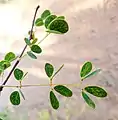Senegalia nigrescens
Senegalia nigrescens, the knobthorn, is a deciduous African tree, growing up to 18 m tall,[1] that is found in savanna regions from West Africa to South Africa. The tree is resistant to drought, not resistant to frost and its hard wood is resistant to termites.[1]
| Senegalia nigrescens | |
|---|---|
 | |
| In Limpopo, South Africa | |
| Scientific classification | |
| Kingdom: | Plantae |
| Clade: | Tracheophytes |
| Clade: | Angiosperms |
| Clade: | Eudicots |
| Clade: | Rosids |
| Order: | Fabales |
| Family: | Fabaceae |
| Subfamily: | Caesalpinioideae |
| Clade: | Mimosoid clade |
| Genus: | Senegalia |
| Species: | S. nigrescens |
| Binomial name | |
| Senegalia nigrescens (Oliv.) P.J.H.Hurter | |
| Synonyms | |
| |
Ecology
Giraffes often browse on the flowers and foliage of this tree, while the seed pods and foliage are browsed on by a range of mammals, including elephants.[2]
Uses
An ointment made from the roots has traditionally been used to treat convulsions.[3]
Gallery
 compound leaves
compound leaves flower spike
flower spike rufous seed pods
rufous seed pods knobbly bark
knobbly bark
References
- Masupa, Thabo. "Senegalia nigrescens (as Acacia nigrescens)". PlantZAfrica.com. National Herbarium, Pretoria. Retrieved 7 October 2012.
- Van Wyk, Piet (2008). Field guide to the TREES of the Kruger National Park. Cape Town: Struik. p. 69. ISBN 978-1-77007-759-1.
- Cumes, David (2009). Healing trees & plants of the Lowveld. Rael Loon, Dries Bester. Cape Town, South Africa: Struik Nature. ISBN 978-1-77007-833-8. OCLC 506229195.
External links
 Media related to Senegalia nigrescens at Wikimedia Commons
Media related to Senegalia nigrescens at Wikimedia Commons Data related to Senegalia nigrescens at Wikispecies
Data related to Senegalia nigrescens at Wikispecies- Senegalia nigrescens (as Acacia nigrescens) in West African plants – A Photo Guide.
This article is issued from Wikipedia. The text is licensed under Creative Commons - Attribution - Sharealike. Additional terms may apply for the media files.